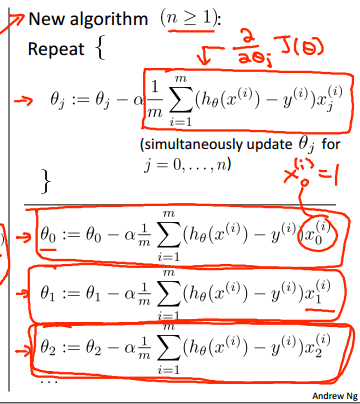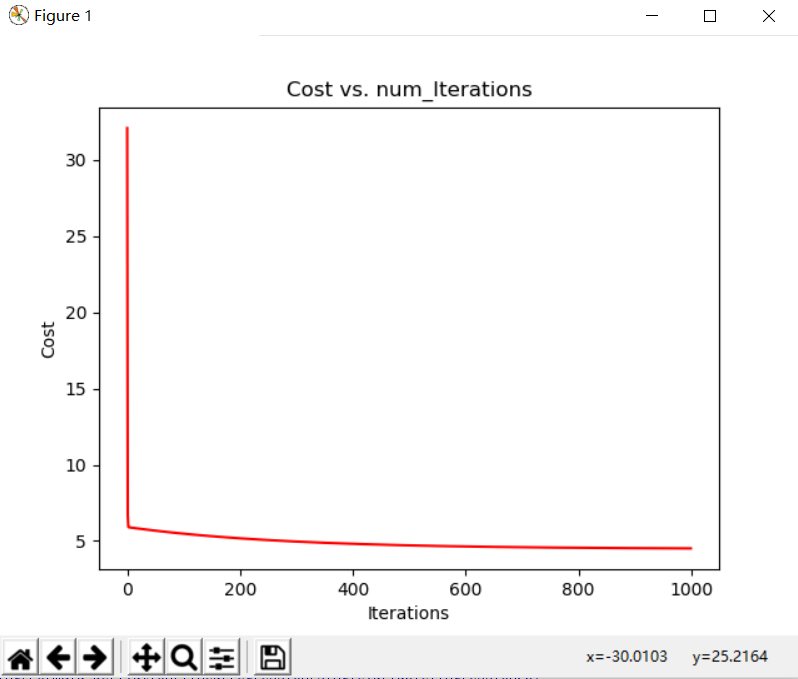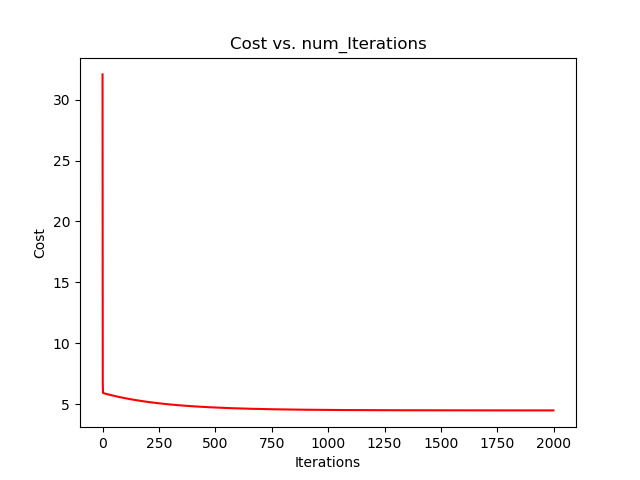回归问题的思想(1)先找到损失函数,(2)求损失函数最小化后的参数
假设我们的数据是(m,n)有m行数据,n个特征(feature)
则我们预测函数为 :
![]()
写成向量形式为(xo=1):

ps:因为存在截距项,这里的X矩阵是n+1维的
定义代价函数CostFunction:
求 minJ(θ)

得到目标函数后,我们目标是想要代价函数尽可能小,利用凸优化知识,对J(θ)求偏导并带入梯度下降公式中:
梯度下降请参考:https://www.cnblogs.com/pinard/p/5970503.html

向量式:i=(1,2,...n)

α是步长,决定更新快慢(过大可能会导致溢出)
到这里就能求出所需要的参数的更新公式。
下面的例子是单变量的例子,用的梯度下降方法,因为可以直接画图出,比较直观。
1 import pandas as pd 2 import numpy as np 3 def CostFunction(x,y,theta): 4 med_var=np.power((x*theta)-y,2) 5 return np.sum(med_var)/(2*len(x)) 6 7 def Grandent(x,y,theta,alphl,maxcircle): 8 m = x.shape[0] 9 print('m=',m) 10 print('theta shape',theta.shape) 11 temp = np.matrix(np.zeros(theta.shape)) 12 print('temp shape',temp.shape) 13 cost = np.zeros(maxcircle) # 初始化一个ndarray,包含每次迭代的cost 14 for k in range(maxcircle): 15 # print(theta) 16 temp=theta-(alphl/m)*(x.T)*(x*theta-y) 17 cost[k]=CostFunction(x,y,theta) 18 theta=temp 19 return theta,cost 20 21 22 data=pd.read_csv('ex1data1.txt',names=['feature','price']) #(97, 2) 23 data.insert(0,'x0',1) 24 X_dataframe=data.drop(['price'],axis=1) 25 y_dataframe=data.price 26 X=np.matrix(X_dataframe.values) #专程矩阵格式 27 y=np.matrix(y_dataframe.values) 28 y=y.T 29 m,n=X_dataframe.shape 30 theta=np.zeros((n,1)) 31 alphl=0.01 #开始设置为0.1,会一直报溢出,导致梯度下降方法不收敛 32 maxcircle=1000 33 34 theta_fin,cost=Grandent(X,y,theta,alphl,maxcircle) 35 36 import matplotlib.pyplot as plt 37 38 fig,ax = plt.subplots() 39 40 ax.plot(np.arange(maxcircle), cost, 'red') # np.arange()返回等差数组 41 ax.set_xlabel('Iterations') 42 ax.set_ylabel('Cost') 43 ax.set_title('Cost vs. num_Iterations') 44 45 #np.linspace()在指定的间隔内返回均匀间隔的数字 46 x = np.linspace(data.feature.min(), data.feature.max(), 100) # 横坐标 47 f = theta_fin[0,0] + (theta_fin[1,0] * x) # 纵坐标 48 fig,ax = plt.subplots() 49 ax.plot(x, f, 'r', label='Prediction') 50 ax.scatter(data['feature'], data.price, label='Traning Data') 51 ax.legend(loc=2) # 2表示在左上角 52 ax.set_xlabel('feature') 53 ax.set_ylabel('price') 54 ax.set_title('Predicted Profit vs. Population Size') 55 plt.show()

下面是迭代1000,2000次的结果


